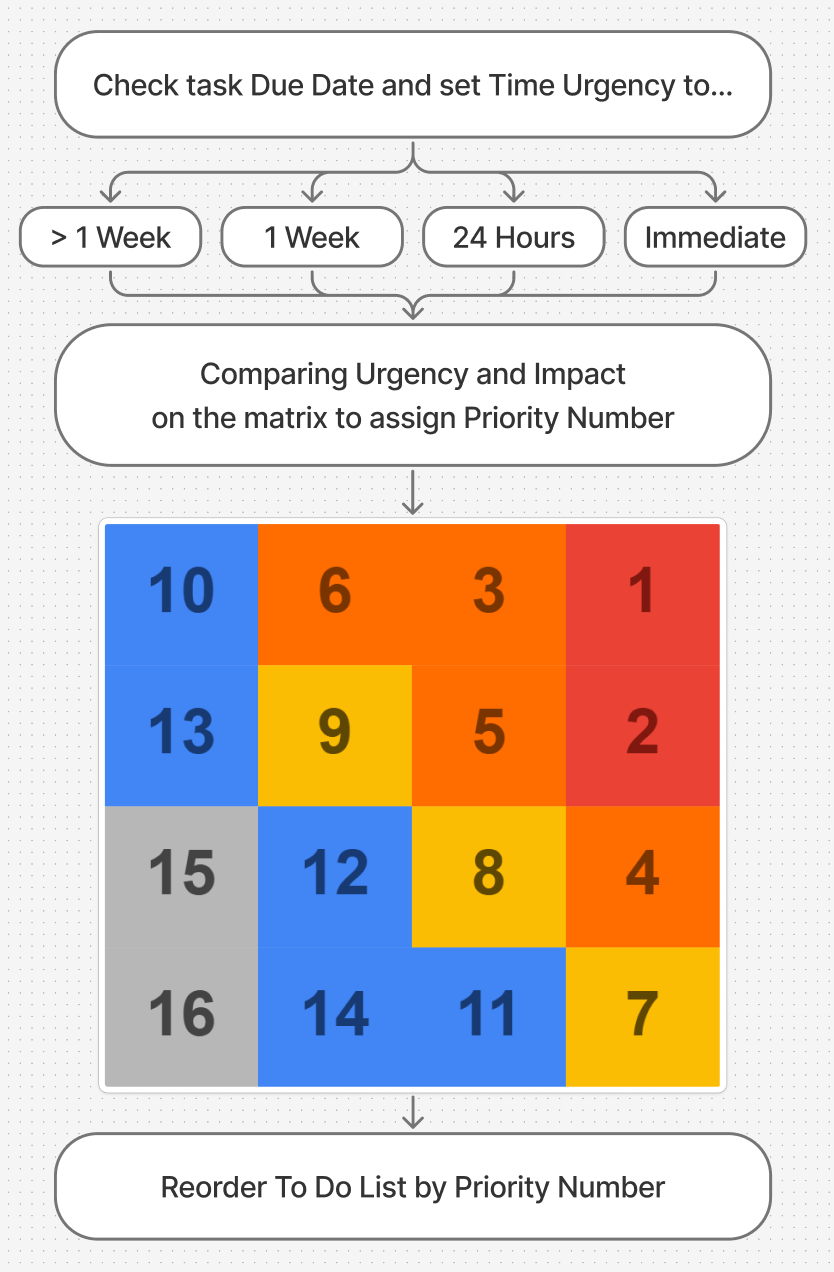For when you have too many things to do and not enough time to decide which to do first.
I’ve always been on the hunt for the perfect way to track and organize my work. Over the years, I have tried many different methods:
- For task tracking: Post-it notes, Trello, Google Tasks, self-DMs in Slack, and countless daily written journal notebooks.
- For prioritization: T-shirt sizing, due dates, last-in-first-out, Eisenhower Matrix, PARA, you name it.
None of them have stuck. The problem? I track everything from casual reminders like needing to chat with a specific person about something small, to hands on supporting a team members project, to writing up documentation, to spending time thinking about a topic at a high level, to putting regular effort towards a large initiative. It’s all valuable, and I want it all logged.
For some of the tools, the logging part actually worked out fine. What didn’t work was prioritizing the endlessly growing list. Once it ballooned beyond 10-15 items, I’d spend 10-15 minutes every morning just figuring out what to do first. As a manager with limited focus time between meetings, I needed a better solution.
Why Manual Task Prioritization Fails at Scale
When your task list crosses 100 items (like it did for me), keeping it manually prioritized feels like a full-time job unto itself. I needed a system that could:
- Handle volume
- Adapt to changing urgency
- Consider task impact, not just due dates
- Update itself without me constantly reevaluating each task
In other words: a dynamic, automated prioritization system.
Why Jira? I figure other task trackers could handle this system, but Jira was my go-to because I’ve essentially lived in it for my whole career as a developer. When I became a manager, I tried to branch out, thinking it was too clunky, but my brain was already wired for Jira’s interface and workflow. Plus, if I’m sharing this with other managers, I didn’t want to throw another software onto their plate. Sticking with Jira just made sense.
How I Automated Task Prioritization in Jira
4×4 Priority Matrix
At the core of my system is a custom 4×4 matrix. Most folks use 2×2 matrices, but I needed more nuance for my highest priority tasks.
Impact Size
- Extensive / Widespread
- Significant / Large
- Moderate / Limited
- Minor / Localized
Time Urgency
- Immediate / Past Due
- Within 24 Hours
- Within 1 Week
- Greater than 1 Week
| Extensive / Widespread |
10 |
6 |
3 |
1 |
| Significant / Large |
13 |
9 |
5 |
2 |
| Moderate / Limited |
15 |
12 |
8 |
4 |
| Minor / Localized |
16 |
14 |
11 |
7 |
|
> 1
Week
|
1
Week
|
24
Hours
|
Immediate
|
This lets me prioritize, say, a widespread-impact initiative due in two weeks over a minor task due tomorrow. The result is a more meaningful prioritization than simply sorting by date or gut feeling.
I’ve experimented with different weightings – some matrices that emphasize urgency, others that put impact as more valuable. There’s no “perfect” matrix. It should evolve with your work and this is where mine has landed.
Automating the Priority Matrix in Jira
Here’s where the real magic happens.
I used to manually tag every new task with Impact and Urgency, cross-reference my matrix, update Urgency as due dates changed, then have to cross-reference my matrix again to assign the Priority Number.
Now, it’s automatic.
Every task gets a due date – even those without a hard deadline, like “evaluate art pipeline.” I just give myself a reasonable target to aim for. Then each morning, a Jira automation rule runs the following actions:
- Checks the current due date
- Updates the Time Urgency field
- Cross-references Impact and Urgency on the matrix
- Sets a Priority Number
- Reorders my list
That’s it. No more fiddling, no more forgetting. Just a neatly prioritized list when I log in each day.

Results
I’ve been using this system for just over three weeks, and already it’s helped me consistently focus on what matters most before I get pulled into a rabbit hole of due-soon-but-low-value tasks.
More importantly, it’s eased that nagging question:
“Am I working on the right thing right now?”
Now, I know I am!
Want to Try It?
Getting the most out of this system is as easy as 1-2-3:
- Capture everything. Big, small, fuzzy, or specific, get it into your system.
- Define your matrix. Choose priority numbers for Impact and Time pairs that make sense for you.
- Automate priority updates. Whether in Jira or another tool, let the system do the thinking for you.
One Thing It Doesn’t Solve
Unfortunately, this won’t give you more hours in the day. If your problem is not having enough time in the first place, no system can fix that, sadly.
But if your problem is too many things to do and no idea where to start, this system might just change your life.
Let’s Chat!
If you try this out, I’d love to hear what works for you and where it falls short. Got improvements? Either way, hit me up on LinkedIn. Or just let me know how cool you think it is (kidding… unless?).